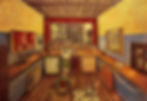Danish Illustration and the Details That Shape My Art
- Liv Hansen
- Jun 21
- 2 min read
Updated: Aug 3
When I draw, I’m drawn to the small, familiar details that are easy to overlook. A train pulling into a quiet station. A window at the summerhouse lit up at dusk. The worn edge of a stairway that’s been part of daily life for decades.
My work as an illustrator is often shaped by these kinds of scenes — moments that could belong to mid-century Denmark, but that still feel close today. I find inspiration in the everyday rhythm of Danish life: a street lamp on a side street, a square aluminum lunchbox, or a bicycle left against a wall. These are small pieces of a larger picture — the quiet, familiar corners of daily life rather than sweeping views.
Sometimes I notice something that brings me back in an instant — the shape of a lampshade that hasn’t changed in fifty years, or curtains just like the ones my grandmother had in her kitchen. These details hold layers of memory and place. They’re part of the shared visual language of a country, and they shape how I try to tell a story in a single image.
Danish illustration, both today and in the past, often focuses on more than just how a place looks — it tries to hold onto how it feels. That’s something I think about in my work. When I choose a scene or a detail to draw, I’m trying to catch the feeling, whether it’s the stillness before a train arrives or the way light falls across a backyard vegetable garden.
I work mainly in colored pencil, sometimes layering in gouache. I’ve recently started working more digitally, but much of my process still begins in sketchbooks — often rough, textural, and unpolished. I’m less interested in perfection than in the mood of a moment. That’s what makes me stop and look. I think this instinct comes from childhood — from the hours spent drawing at the kitchen table in Denmark, or studying the way shadows shifted across the walls of my grandmother’s house in the Danish countryside. That sense of quiet has stayed with me, even now. I wrote more about how that rhythm shapes my days here
➡️ Explore more of my work as part of today’s Danish illustration scene here.

